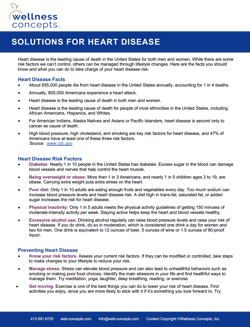Heart disease is the leading cause of death in the United States for both men and women. While there are some risk factors we can’t control, others can be managed through lifestyle changes. Here are the facts you should know and what you can do to take charge of your heart disease risk.
PREVENTING HEART DISEASE
- Know Your Risk Factors. Assess your current risk factors. If they can be modified or controlled, take steps to make changes to your lifestyle to reduce your risk.
- Manage Stress. Stress can elevate blood pressure and can also lead to unhealthful behaviors such as smoking or making poor food choices. Identify the main stressors in your life and find healthful ways to manage them. Try meditation, yoga, laughter, deep breathing, reading or exercise.
- Get Moving. Exercise is one of the best things you can do to lower your risk of heart disease. Find activities you enjoy, since you are more likely to stick with it if it’s something you look forward to. Try enlisting a workout buddy to hold you accountable. Tracking your exercise can also be a fun way to stay motivated.
- Maintain a Healthy Body Weight. Being overweight increases the risk of developing many diseases, including heart disease. Limit caloric intake and balance your intake with exercise.
- Practice Portion Control. Eating modest portions is necessary to control your weight. Portion control also limits the amount of saturated fat, trans fat and added sugar you consume, which are factors that aggravate heart health. Fill your plate at each of your meals like the MyPlate example for overall portion control and nutrient balance. Visit www.myplate.gov to learn more.
- Eat more vegetables and fruits. Vegetables and fruits contain antioxidants, phytochemicals, fiber and other plant compounds that prevent disease, including heart disease. Not only do they provide protective nutrients, but they also make you feel full, which helps you minimize the amount of unhealthy fats and sugar you consume. Enjoying a variety of fruits and vegetables of different colors will provide a variety of nutrients. Eat the rainbow every day!
- Enjoy small portions of whole grains. Whole grains are made with the whole grain and all its fiber, vitamins, minerals, and phytochemicals. Refined grains (like white bread, white rice, white pasta) are missing these nutrients. Enjoy whole grains like oats, brown or wild rice, and quinoa. Check food labels for at least16 grams of whole grain and 3 grams of fiber per serving. Also check for "whole grain" as the first ingredient for breads, pastas, cereals, crackers and other grain foods.
- Enjoy protein at each meal. Protein preserves lean tissue (like heart muscle), helps with blood sugar control (which helps minimize heart damage), and plays a part in important functions like blood pressure control. Enjoy plant-based protein foods like beans, nuts, seeds, and soy products. Fish and seafood are excellent sources of protein and heart healthy fats. Cut down on the unhealthy saturated fats in animal foods by choosing lean meats and low-fat or nonfat dairy foods (milk, yogurt, cheese). Eggs are a great source of protein - use caution with the yolks, which contain some saturated fat but also sources of vitamin D and antioxidants lutein and zeaxanthin.
- Use heart healthy fats. Unsaturated fats can help lower LDL (lousy) cholesterol and raise HDL (healthy) cholesterol. Enjoy olive oil, canola oil, nuts, seeds and avocados. Omega-3 fats found in fatty fish (like salmon and herring), walnuts, flax and chia seeds, and soy foods help lower your risk of heart disease and stroke. All fats, healthy or not, are high in calories. Limit portions of all fats to help with weight control.
• Limit saturated fat and trans-fat. Saturated fats and trans-fat (also known as hydrogenated fat) can elevate LDL (lousy) cholesterol levels. Limit butter, full-fat dairy (milk, yogurt, cheese), fatty meats and processed/ baked/ fried foods.
• Cut down on salt. Too much salt (sodium) in the diet can raise blood pressure levels and therefore increase our risk of heart disease. Sodium is found in find processed, packaged foods and restaurant/fast food. Add flavor by cooking with garlic, onion, peppers, herbs and spices. Use low-sodium or salt-free versions of soups, salad dressings and other processed foods.
• Limit added sugar. Excess sugar intake can lead to obesity and poor control of blood sugar, blood pressure and cholesterol, all of which may lead to heart disease. Avoid excess sugar in foods like sweetened beverages (soda, sports drinks, lemonade, tea, coffee drinks), candy, and desserts.
Want to learn more? Download the Solutions for Heart Disease handout and share with your friends, family, and colleagues.
Related Blog Posts
View All Blog Posts
Corporate Wellness Blogs
3 min read
| October 20, 2025
Workplace Conflict - Smoothing the Waters
Read More
Disease Prevention
1 min read
| October 10, 2025
Weight Management for Disease Prevention Pop Quiz
Read More
Corporate Wellness Blogs
5 min read
| October 6, 2025


 Solutions for Heart Disease
Solutions for Heart Disease